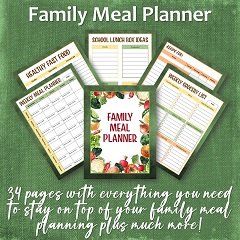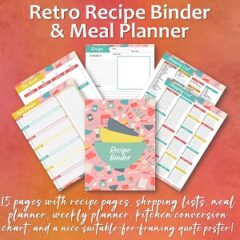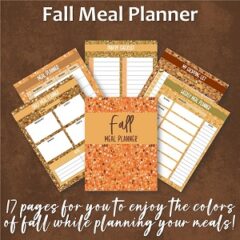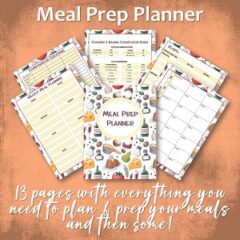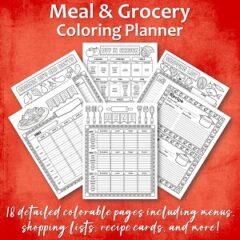 Looking to keep your kitchen optimally organized while saving money? Want to cook, serve and store delicious, healthy meals in less time and for less money? Add these kitchen essentials to your life for a cooking helper and cleaning shortcut.
Looking to keep your kitchen optimally organized while saving money? Want to cook, serve and store delicious, healthy meals in less time and for less money? Add these kitchen essentials to your life for a cooking helper and cleaning shortcut.
Pyrex Storage Containers With Lids
What is there to love about Pyrex storage containers? A lot, apparently. (I remember when they first came out and they were a life saver!)
- They go from oven to table to fridge to dishwasher to cabinet and back again.
- They’re easy to clean.
- They’re dishwasher-safe.
- They’re microwave and oven-safe (remove plastic lids first).
- They transport well.
- They stack well in the cabinet.
- They don’t stain like plastic.
- They don’t all topple over like plastic containers do when you open the cabinet door.
Crock Pot/Slow Cooker
A crock pot or slow cooker is the working mom’s life-saver. Get into the habit of filling the crock pot with fresh ingredients, early in the morning. You’ll have a hot, healthy dinner ready and waiting for when you get home.
Your crock pot is also great for simmering up a pot of bone broth to store in your freezer and thaw for recipes as needed. You can leave the house while your broth cooks slowly, over a day or several days if you wish.
Meals that are perfect for the crock pot: Soups, stews, sauces with meat and veggies added.
Crock pots are great because:
- One-pot cooking means less mess.
- If you’re cooling food down and need to step out, you can just pop the crock pot into the fridge with a lid on top.
- Crock pots are easy to clean and store.
- You can be out and about, or at work all day while dinner slowly and safely cooks away.
Blender
A blender is a must-have for the busy, healthy cook. Keep yours on the counter top or stow away in the lower cabinets when not in use.
What can you make with a blender?
Morning Smoothies
Use plain yogurt, bananas, frozen fruit and even sneak in veggies like frozen spinach, or nuts and seeds for healthy fat and extra fiber.
Homemade Salad Dressing
Japanese ginger dressing, home style Italian, cucumber dressing, avocado dressing and other favorites whip together in minutes when you have your handy blender at the ready.
Hummus and Bean Dips
Black bean, white bean, chick pea hummus and other tasty, healthy dips can be made quickly and easily in the blender.
Pureed Soups
Whirl butternut squash, pea soup, cream of spinach, tomato soup or pretty much any simple soup in the blender for a sophisticated yet simple start to your dinner, or on the side with your lunch sandwich.
Benefits of a blender:
- Easy to take apart and clean.
- Some have storage cups with lids so you can go from counter to fridge.
- Fun to play with the consistency of foods.
- Blended foods can be easier to digest.
- You can take a shortcut from chopping – use the grind and pulse mechanisms.
- Blend up flours from chickpeas and almonds to make gluten-free recipes.
Pressure Cooker
A pressure cooker is a lifesaver for those evenings when you’re short on time and dinner prep is in order. Speed up cooking of the following:
- Stews that should be slow-cooked for best texture and taste
- Pot roasts
- Dried beans and legumes
- Bean-based soups
- Soups that contain slow-cooking ingredients, like cabbage and potatoes, or beets and turnips
Why is a pressure cooker an asset to your kitchen?
- Cuts cooking time from hours down to minutes.
- Preserves the nutritional content of the foods you’re making.
- One pot means less mess.
- They’re fast and easy to clean.
Toaster Oven
A toaster oven is a handy thing to have when you’re looking to heat up food or make a quick, small portion. Foods to make in the toaster oven (remove the metal tray and set to Toast cooking mode.)
- Toast
- Bagels
- Muffins
- Waffles
Foods that can be cooked quickly in the toaster oven, with tray in and set to desired baking temperature:
- Grilled cheese
- English muffin pizzas
- Frozen appetizers like pigs in blankets, mini egg rolls, pizza rolls or taquitos
- Frozen burritos, hot pockets, already-cooked empanadas
- Chicken nuggets and fish sticks
- Already-cooked solid foods that you’re reheating, like leftover chicken parm, French toast.
What’s to love about a toaster oven?
- Cooks small amounts of food relatively quickly.
- Saves money on the electric or gas bill by not having to use the oven.
- Keeps the big oven cleaner, longer.
- Useful for getting preteens and teens started with cooking and heating up meals on their own.
Helpful toaster tips:
- For easy clean-up, line the metal toaster oven tray with aluminum foil. Replace as necessary.
- Avoid letting the food you’re reheating touch the top heating element as this can start a fire.
- A toaster oven with a bottom that pulls out can make clean-up even easier. Just empty over the garbage pail or outside bin, to reduce mess.
- Check the package directions of any food you’re heating or cooking, to be sure you’ve set the right temperature and cooking time.
- You can cook liquid foods in a toaster oven with the tray in, if it’s a small serving, contained in a small Pyrex cup or bowl. Just be sure the food isn’t touching the heat element, and that there is plenty of room for air flow all around.
Dutch Oven, Big Skillet, and/or Wok
The object here is to move your dinner-making practice to Just One Pot as often as possible. When cooking on the stove top, these are a must.
Care and cleaning of your “big pots”:
- Dutch oven care and cleaning: If you don’t care to clean a large pan, do the dishes first, then leave to soak in the sink.
- Cast iron should be wiped clean and not permitted to soak in water, as this creates rust. To get rid of rust that has formed on your cast iron pan, rub olive oil and apple cider vinegar on. Let sit, then wipe off.
- Your wok works best if wiped clean and then oiled between uses.
Cooking in a cast iron skillet delivers iron to your body through your food. What a great, easy way to get the essential mineral that brings energy to your body.
Mason Jars
Mason jars afford endless uses for the smart home economist and creative cook. Use them to preserve and store food- canning at home. There is a specific process to doing this, and safety should be the priority.
Consult with a canning guide for specific instructions on:
- Proper temperature
- How to sterilize jars and lids before use
- What foods you can safely keep in canning jars and for how long
- How to ensure the proper seal for safe, prolonged storage
- And many other canning-specific details.
What else can you do with Mason jars?
- Ferment pickles, cabbage and other veggies, to preserve and keep in the pantry, or store in the refrigerator.
- Use them in place of plastic storage containers. This works well if you have small amounts of foods that you’d like to store, such as olives, apple sauce, soup, tomato gravy or any other random leftover from your meal.
- Keep iced coffee and iced tea in them and place on your refrigerator shelf.
- Mix up a quick homemade salad dressing or dip. Use the jars to store and save for later use during the week.
- Make hand-poured Mason jar candles to warm and brighten your home, or offer as gifts.
- Line them up on a shelf of your crafting room to store crafting supplies.
- Use them to serve layered desserts.
- Make overnight oats – grab and go for a quick, nutritious morning meal.
- Store homemade granola in them.
- Store bulk spices in them such as cinnamon sticks, cloves, peppercorns. They’ll look nice decorating the kitchen shelf!
- Fill them with homemade broth and freeze (be careful not to over-fill your jars, as they will expand and can crack and break once frozen).
